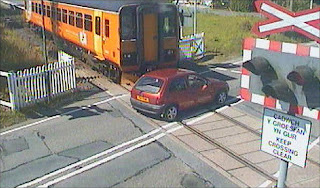Four-way stops, also known as all-way stops, are a very common road way feature.
A Typical Four-Way Stop
Here are some common elements of these traffic control devices.
Typical Four-Way Stop Sign
4-way intersections are always marked as such, and you are always required to come to a complete stop.
'STOP' painted on the road way
Lettering will frequently be applied to the area directly in front of the intersection to further indicate to the driver that a complete stop is required.
Blinking Lights
Blinking lights will sometimes be used to further draw attention to the driver that they must come to a complete stop.
Typical Layout of a 4-Way Stop
A 4-way stop will typically have the above geometry.
A Crosswalk
4-way stops will sometimes incorporate a cross-walk.
Cross walk sign
Additional cross walk signage is sometimes used.
Cross walk signal
Pedestrians will sometimes be signaled to cross with a cross walk signal at busier intersections.
Multi-Lane 4-way Stop
A four-way stop may have more than two lanes coming from each direction.
Crowded Intersection
Sometimes a simple 4-way stop is not sufficient to handle traffic volumes.
NEXT TIME: PEDESTRIAN WALKWAYS














.jpg)
.jpg)

.jpg)

.jpg)
.jpg)







.jpg)










.jpg)



.jpg)







